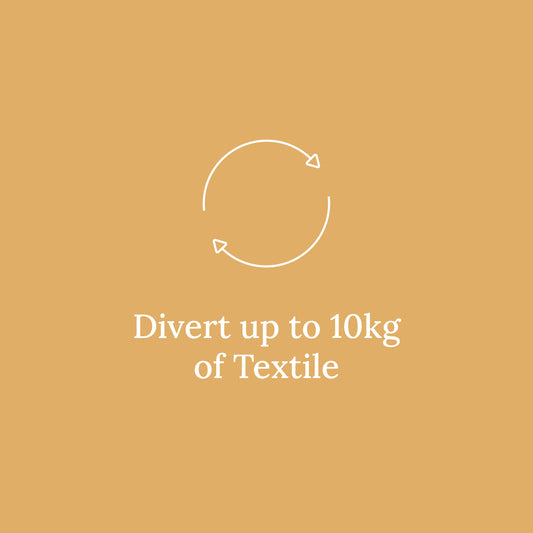ReFab Bag Service
Sustainability
Dimensions
Why Recycle Your Textiles with ReFab?
With ReFab, you're doing more than just tidying up – you're joining a crucial fight against textile waste. Every kilogram you pack helps reduce 3-4kg of greenhouse gases, making a real impact. You're also backing local communities with every item you send. At ReFab, we try our best to give your textiles a new life – through reuse, repurposing, or recycling, right here in Canada.


What Happens to Your Unwanted Textiles at ReFab?
We are committed to zero landfill waste. Currently, around 60% of the items we receive are either new or in good condition. Our team meticulously sorts these items, which are then shared with our trusted Canadian charity partners. The remaining 40% of items are creatively repurposed by local communities or transformed into innovative materials, contributing to the circular economy.
What types of items do we accept?
We welcome all textiles, regardless of their condition, as long as they are clean. This includes items that are brand new or have significant wear and tear, such as rips, stains, or holes. We kindly ask that you wash all items before sending them to us for recycling.
✔️ Home textiles: Such as bedding, crib sheets, towels, dishcloths, curtains and drapes, decorative pillow covers, quilts, throw blankets, pet beds covers.
✔️ Apparel Items: Including jeans, shirts, jackets, and more.
✔️ Fabric Remnants and Sewing Scraps: Leftover pieces from your sewing projects.
✔️ Wire-Free Bras: Including bras that have had their wires removed.
✔️ Socks: All kinds and sizes.
✔️ Hats
✔️ Non-Waterproof Mattress Covers: Fabric-based protectors only, please.
✔️ Soft Furnishings: Like fabric couch covers and drapes.
✔️ Swimwear: Including bathing suits and other aquatic apparel.
Are there items you don't accept?
✖️ Duvets/Comforters: hygiene reasons.
✖️ Pillows: hygiene reasons.
✖️ Dirty Items: Everything needs to be clean for us to accept it.
✖️ Used Undergarments: For hygiene reasons, we cannot take used underwear, wired bras, etc.
✖️ Cloth Diapers: These need special disposal methods.
✖️ Carpets: Their size and materials make recycling difficult.
✖️ Synthetic Leather: Materials like PU leather can’t be processed here.
✖️ Plastic Bags: Including Polypropylene (PP) bags.
✖️ Bags: This includes all types of handbags and duffel bags.
✖️ Belts: Due to their unique materials and construction.
✖️ Stuffed Animals: Their varied materials complicate recycling.
✖️ Wired Bras: The wires and specific construction are problematic.
✖️ Shoes: at the moment we do not accept footwear.
How does ReFab handle my unwanted textiles?
We ensure everything is reused, repurposed, or recycled right here in Canada, committing to a zero landfill policy. Approximately 60% of received items are in prime condition and are shared with our Canadian charity partners. The other 40% is creatively repurposed or turned into innovative materials by local artisans.
Why is there a $25 fee for a ReFab Bag service?
This fee is covering the operational costs of our textile recycling initiative, including transportation, storage, sorting, and processing of the textiles, as well as distributing reusable items to our Canadian charity partners. As an independent Canadian business, this fee is vital in supporting our mission to eliminate textile waste and promote sustainability.
Will you make new clothes out of the items I send?
No, at present, transforming old clothes directly into new ones is a significant challenge. The technology required for fiber-to-fiber recycling is still in development and not yet ready for widespread industrial use. Our approach, therefore, focuses on finding new purposes for your old items, such as resale or repurposing, to effectively divert them from landfills. While creating new clothing from old is an eventual goal, currently, we are taking smaller steps towards achieving a fully circular industry.
Will my items end up in second-hand clothing markets overseas?
We are committed to responsible practices and work closely with local partners who align with our vision of zero waste. We ensure that these partners are diligent and ethical in their operations, striving to keep the reuse and repurposing of items within local contexts as much as possible.
What is the best way to empty our closets without adding to the piles in landfills?
The key is extending the life of your clothes. As a brand, this means adopting demand-based sourcing and production models to avoid overproduction and waste. For individuals, it’s about finding creative ways to reuse clothes - like repairing them, participating in clothing swaps, passing them on to family or friends, or sending them to programs like ours. We ensure that your clothes are given a new lease on life in the hands of someone who can use and appreciate them.




